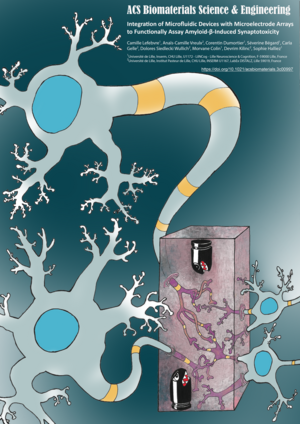
Sophie Halliez
Research areas
Modelling brain networks to study neurodegenerative proteinopathies
How to target synapses
Alzheimer’s disease (AD) is a neurodegenerative disease and the most frequent cause of dementia. It is characterized by the accumulation in the brain of two pathological protein aggregates: amyloid-β peptides (Aβ) and abnormally phosphorylated tau. The progressive cognitive decline observed in patients strongly correlates with the synaptic loss. Many lines of evidence suggest that soluble forms of Aβ accumulate into the brain where they cause synapse degeneration. Stopping their spreading and/or targeting the pathophysiological mechanisms leading to synaptic loss would logically be beneficial for the patients. However, we are still far from understanding these processes. Our objective was therefore to develop a versatile model to assay and study Aβ-induced synaptotoxicity. We integrated a microfluidic device that physically isolates synapses from presynaptic and postsynaptic neurons with a microelectrode array. We seeded mouse primary cortical cells in the presynaptic and postsynaptic chambers. After functional synapses have formed in the synaptic chamber, we exposed them to concentrated conditioned media from cell lines overexpressing the wild-type or mutated amyloid precursor protein and thus secreting different levels of Aβ. We recorded the neuronal activity before and after exposition to Aβ and quantified Aβ’s effects on the connectivity between presynaptic and postsynaptic neurons. We observed that the application of Aβ on the synapses for 48 h strongly decreased the interchamber connectivity without significantly affecting the neuronal activity in the presynaptic or postsynaptic chambers. Thus, through this model, we are able to functionally assay the impact of Aβ peptides (or other molecules) on synaptic connectivity and to use the latter as a proxy to study Aβ-induced synaptotoxicity. Moreover, since the presynaptic, postsynaptic, and synaptic chambers can be individually targeted, our assay provides a powerful tool to evaluate the involvement of candidate genes in synaptic vulnerability and/or test therapeutic strategies for AD.
Currently looking for a student to develop a new thesis project !
Title : Study of neuron-astrocyte interactions in Alzheimer’s disease models using microfluidic devices and microelectrode arrays
Supervisor : Sophie Halliez (sophie.halliez@univ-lille.fr, ORCID Number : 0000-0002-6173-9752)
Start date of thesis : 1st October 2025
Funding : GRAEL (GRAduate Education in Lille) fellowship (3 years)
Summary :
Alzheimer’s disease (AD) is a neurodegenerative proteinopathy characterized by the abnormal accumulation of extracellular β-amyloid (Aβ) deposits and intracellular tau-containing neurofibrillary tangles in the brain. Besides the accumulation of proteins as well as synapse and ultimately neuronal loss, other cellular dysfunctions are observed in the AD brain including neuroinflammation, mediated by reactive microglia and astrocytes. In AD, the latter have been particularly described to exhibit an upregulation of the adenosine A2A receptor (A2AR) which leads to impaired neuronal function. This would explain the protective effect of caffeine, pharmacologically being a non-selective antagonist of A2AR.
It is now obvious that targeting only one pathological aspect of AD is not enough to drastically reduce its progression. To develop efficient (and probably combined) multicellular-based therapies, we need to better understand the interactions between the different cell types and identify associated pathways. In the present project, we will focus on the neuron-astrocyte interactions at the synapse in an AD-like context and through the prism of the dysregulation of A2AR by the astrocytes. In a first attempts, this will be achieved by using a cell culture system encompassing a 3-compartment microfluidic device associated with a microelectrode array (MEA). This system allows us to study the synapse function with regards to the single and combined effects of astrocytic upregulation of A2AR receptors and the presence of tau fibers (and possibly Aβ). Then, we will address these regulations using a more complex network by using organotypic hippocampal slice cultures prepared on MEAs and undergoing tau pathology development. Lastly, we will use both models to assay some therapeutic strategies developed by our collaborators.
This project should allow to better understand how tau pathology and modulation of the expression of A2AR by the astrocytes detrimentally interact together in AD to affect the synaptic function and brain network connectivity.
Profile and skills required :
- Educational Level: Master in cell biology, neuroscience or engineering
- Serious, motivated and highly committed student
- Knowledge in cell neurobiology
- Experience in primary cell culture
If you are interested, send CV and motivational letter including contact information for two references at sophie.halliez@univ-lille.fr




